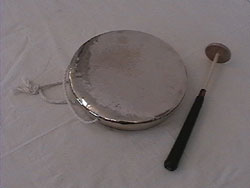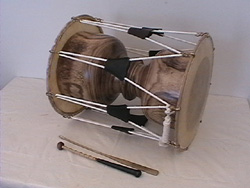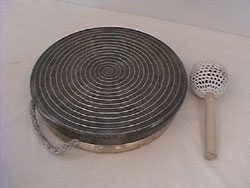|
|
 Instruments Instruments |
| |
Samulnori is composed of the followoing four instruments.
|
Kwengguari
Kwengguari (or called Soe) is made of bronze and cords are attached to its edge. The performer holds the instrument by the cords and strikes it with a stick called “chai” which is made of wood. It is the lead instrument for samulnori and pungmul and represents thunder. |
| |
|
Janggo
The body of Janggo is made of wood in an hour glass shape. Both drum heads are made of horse skin. Left side is thicker than right side creating two different pitches. The left side is stuck with a beater made of bamboo or wood, and the right side is struck with a thin bamboo stick. The leather clasps along the cords are used to control tension of the drum heads. |
| |
|
Jing
Jing is a type of gong made of bronze. A groove spirals on the surface of some jings. A cord is attached to the edge for hanging on a wooden frame while performing although the performer sometimes holds it by the cords for performances. The mallet, called chai, is made of a wooden handle with soft cloth-covered round head. |
| |
|
Buk
The body of the buk is made of wood. The head is made of cow or horse skin and is attached to each side of the body with a thin cord. It is struck with wooden beater. The pitch is the same on the both sides. |
|
| Each of these four instruments has its own meaning and such as Kkwaenggari, Janggu, Buk and Jing represent star, human, moon and sun respectively. In addition, the sound of each instrument can be compared with lightning, rain, cloud and wind. Kkwaenggari means 365days, Jing means 1 year, Buk symbolizes 4 seasons, and Janggu implies 12 months. |
|

![]()



